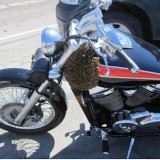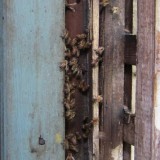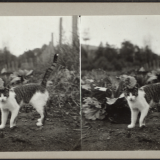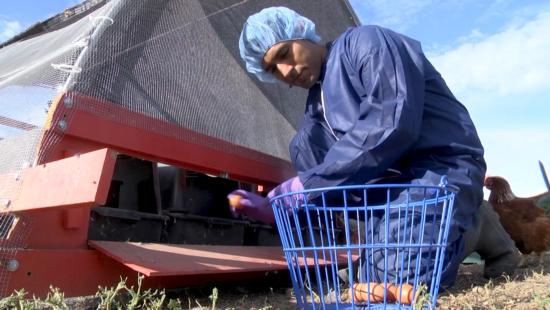
Don’t know much about this native bee house other than that it’s near Paris.
For more info on native bee habitats, see our post from earlier this year.
Update: reader Drew left a comment to say that this habitat is in the Jardin des Plantas in Paris which is attached to the Muséum national d’histoire naturelle (http://www.mnhn.fr/le-museum/).
Thanks to David Dalzel for the tip.






Wow, that’s really a piece of art. I made two Mason Bee houses towards the end of Summer. They’re both still hanging and unoccupied. This being my first attempt, can anyone tell me when I can expect some bee activity? I guessing early Spring?
Did you try a variety of hole sizes? Also, some sun is good. The one I put up, facing east filled up within a month last year and appears to be occupied again.
And adding to Erik’s answer: yes, you’ll see lots of activity in the early spring, esp. with the coming of the fruit tree blossoms (though there are lots of different pollinators with different diets) Remember, too, that most of these little pollinators have very short ranges, so to have an active house, you need to have lots of resources for them close at hand.
Mr. & Mrs. Homegrown,
I just read an interesting review of a book, I’ve just ordered, which I learned about from Anderson Cooper’s interview of the author:
“These shooters are rarely loners. They are “failed joiners.” The difference is important. A loner absents himself from social contact and withdraws from the world around him. Shooters are engaged, but not successful. They reach out to cliques, only to be rebuffed. Their daily social experience is of rejection and frustration, not isolation.” http : // http://www.socresonline.org.uk/10/3/reviews/ davies. html
In the coming days pundits will talk about gun laws, mental health and even “hardening” our schools like prisons, all interesting perspectives on how to stop the next inevitable shooting.
I was hoping here at Root Simple, you guys can open the forum up to DIY, simple, sustainable, cost effective, community based solutions addressing the above quote. Thank you.
“…the best bet we have for prevention lies not in trying to identify the people who are going to shoot their teachers and classmates- though preventative mental health measures are good policy across the board- but rather on intercepting the flow of information when the threats fly.”
Solutions have to do with the organization of schools and the relationships between individuals, families, and our institutions.
Rachel,
We feel like this topic is off-topic for our blog–for the same reason we do not read the paper or own a television. It’s not that we don’t care, but, well, it would take an essay to explain all that. To stick to the point, we are posting your comments and responding to them here because we honor your pain, and your concern.
If we were to offer any theory, it would be this: mass killings are driven by media attention. Realistically there is no solution per se for the problem–this sort of thing will happen sometimes, one way or another, no matter what we do–but I do believe that we can ask the media to behave more responsibly.
If the media would–for decency’s sake- put a moratorium on their sensationalist coverage I believe the problem would decrease dramatically.
The shooters know that they’ll go out in a blaze of glory, and be “admired” by a shocked nation which is glued to the 24hr/day media frenzy.
What other criminals get this level of coverage? The shooters know they’ll be famous because they’ve grown up watching other shooters receive the very same attention. These are people who feel as if the world owes them something. They know that the world is guaranteed to take notice of them.
What should happen is that their crimes should be relegated to a two line story on page 3. Their pictures should not be broadcast. As a society, we should not speak their names. We should not give them any attention at all. What does the phrase “unspeakable act” mean, anyway? The murderers should be unremembered, shunned, utterly rejected from the tissue of our collective body.
As a side note, I’d add that it is also important to keep perspective at times like this. The media is very good at engaging our imaginations and fanning our emotions, and then those high emotions get echoed and reinforced through social media. But it is important for our own health and mental balance to remember that as horrific as these acts are, they are relatively rare.
I’ve heard that in the US about 150 people die each year in mass killings, and that number has been pretty stable over time. And that is horrible, of course. But we also have more than 15,000 murders a year. And even more suicides. And how many people die in traffic accidents? And how many of them are children? Some of this is reported, of course, but nothing gets media adoration like our dark folk heroes, our mass shooters. I think it’s time it stopped.
a thought of mine after this newest tragedy was exactly about the amount of people killed in vehicle accidents – in the state i work in, there are message boards all over the interstate that read out on amber alerts, safety notices like “dont drink and drive”, but also and i look at them every time i go to work and the number rises and rises…they display the year to date total of people killed in vehicle accidents in the state….last count was 925 – for 2012. for one state. i always wonder how many people even look at the signs or reflect on the fact that there are 925 families grieving…or care….or stop speeding over 80mph….or stop talking/texting on the phone while driving….it is sad really…talk about tragedy.
i really appreciate that you all dont read or watch the news. my gramma never ever did and she was a pretty happy peaceful woman.
and I appreciate your response as well….very well thoughtout.
How cool! Inspiring me to do some research on native bee habitats.
How tall is the bee house? I can get nothing in the background to give a bit of perspective. It appears to be (in my head) to be about six-feet tall, but that cannot be possible.
I think it’s at least 6 feet–it’s a big one!
I believe this bee house is at the Jardin des Plantas in Paris, attached to the Muséum national d’histoire naturelle (http://www.mnhn.fr/le-museum/).
The gardens are lovely, and if you are in Paris, a nice green space to take a break.
Thanks! Would love a trip to Paris!
I was in the Jardins des Plantes about ten years ago when I came across a carefully-labelled example of “burdock” in the American section. Regular old “burrs” from my childhood. It was fall, so there it was, all brown and fuzzy — cracked me up during a trip I’d taken to escape an anniversary of grief here at home. One of my very favorite memories (that and the American girl who thought I was French and asked, en francais, if I had change for the toilet).
Pingback: Osmia lignaria | Under the Pecan Leaves
Here’s a link to an article about the bee hotel on the website of L’Office National des Forêts:
http://www.onf.fr/@@display_event.html?oid=IN0000000f23
Pingback: Creating Native Bee Homes | Pollinator Link